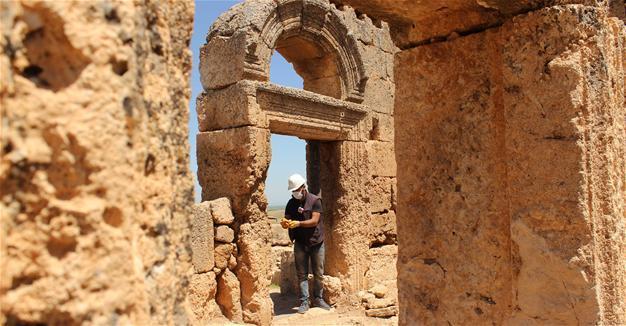Underground Mithras temple discovered in Diyarbakır
DİYARBAKIR – Anadolu Agency

Excavations being carried out in the Zerzevan Castle in the southeastern province of Diyarbakır’s Çınar district have unearthed a Mithraea, an underground temple where a pre-Christian cult gathered and performed rituals 1700 years ago.
The castle, which is located in the Demirölçek neighborhood, 13 kilometers away from the district, served as a military base in the Roman era. Excavations in the castle have been ongoing since 2014 with the contributions of the Culture and Tourism Ministry, Diyarbakır Governor’s Office, Çınar District Governor’s Office and Dicle University.
On an area of a 60,000-square meter field lies the remains of 12 to 15-meter-high and 200-meter-long walls, 21-meter-high watch and defense tower, church, management building, residences, granary and weapon storage, underground sanctuary, shelters, rock tombs, water tunnel and 54 water cisterns.
The archaeological excavations have so far unearthed an underground church, a 400 person-capacity underground shelter, residences and secret tunnels.
The most recent discovery at the excavation site was this 700-year-old underground temple of the Mithras religion, which had its center in Rome but lost its popularity after Christianity rose to prominence.
Çınar District Governor İsmail Şanlı said the cities of Diyarbakır and Mardin can be seen from the Zerzevan Castle.
He said the castle had been reinforced throughout history, and armies had to conquer the castle to be able to claim ownership over Diyarbakır.
Şanlı said the castle was old as the city, and excavations had been continuing for four years there.
“Our goal is to unearth this historic structure. We find a new structure every year in the castle; they shed light on history. The excavations will add long-term value to the region’s tourism and economy,” he said, adding that many people visited the city on weekends to see the excavations.
Given the political instability in the region, not even anti-terror operations ceased people from visiting the excavations, according to Şanlı.
Castle’s effects on tourism Aytaş Coşkun, the head of the excavations and academic at Dicle University’s archaeology department, said the temple was the only Mithras one on the eastern border of the Roman Empire, which attributes more to its significance.
The goddess Mithras was popular and highly beloved among Roman soldiers, according to Coşkun.
“The believers of this religion were a closed group of people, as their ceremonies were totally closed and clandestine. Mithras is the goddess of sun and it also symbolizes the agreement. Generally, temples were built underground. We see three niches in the eastern part of the temple. In one of the niches, there is a very nice water basin. There is a pool on the ground. We know that water was very important in Mithras ceremonies and around 40 people used to attend these ceremonies,” he said.
Coşkun said Mithraism lost its influence as Christianity became more popular, adding that the religion’s most prevalent age was the time when the underground temple was being built.
He said the temple was 35 meters in width and 2.5 meters in height. “Generally, they were not very big structures since they were established underground,” he added.
 Excavations being carried out in the Zerzevan Castle in the southeastern province of Diyarbakır’s Çınar district have unearthed a Mithraea, an underground temple where a pre-Christian cult gathered and performed rituals 1700 years ago.
Excavations being carried out in the Zerzevan Castle in the southeastern province of Diyarbakır’s Çınar district have unearthed a Mithraea, an underground temple where a pre-Christian cult gathered and performed rituals 1700 years ago.